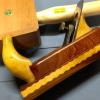I had a major disaster with with my flush cutting bit last night. I needed to trim my face frame edges so I used a brand spanking new flush cutting bit. As I started trimming, the wood (birch) began not just tearing out but splitting out. I have one spot where a huge chunk (maybe 1/8" deep x 1") was torn out (I have no idea how I'm going to fix that). I tried slowing my feed rate, speeding it up, nothing seemed to help.
What did I do wrong? I've done flush trimming before with no problem but this is the first time I tried to trim anything this wide (3/4") but at thickest part I was trimming <1/8" at most. The only thing I can think of is the bit diameter was too small. Is there a rule of thumb for the bit diameter vs. the width of the material to be trimmed? It seemed the larger the diameter the shorter the blades was the way the case was stocked at the store. The bit I used was 3/8" because it was the only one that was 1" long.




 Reply With Quote
Reply With Quote



